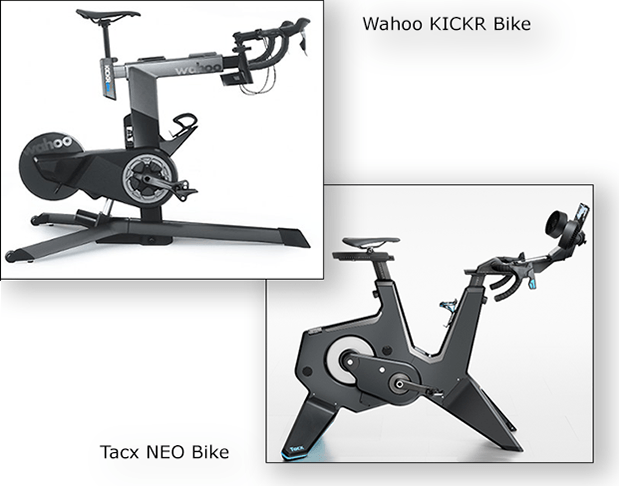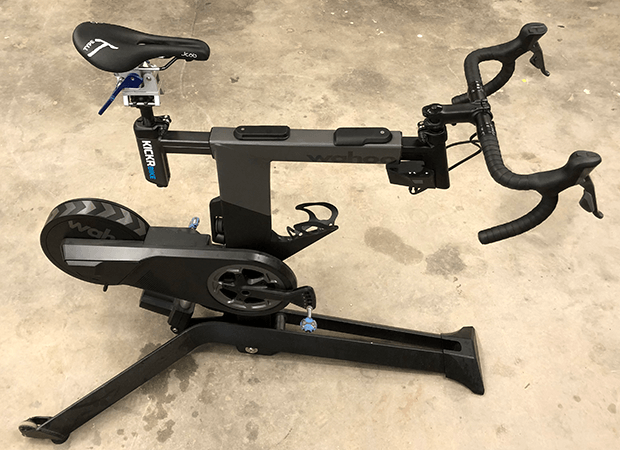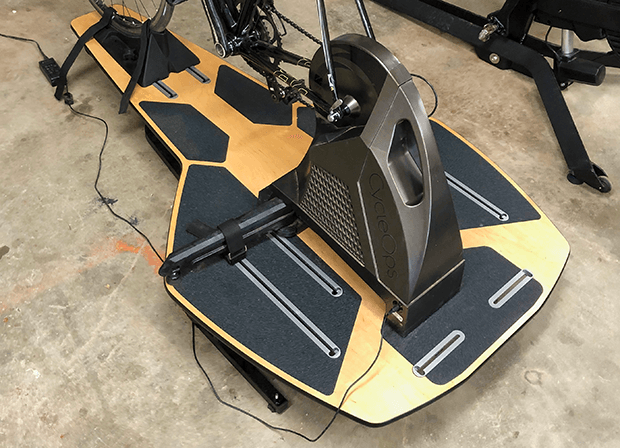Wahoo Fitness Releases 5th Gen KICKR
When smart direct drive trainers came along they were loud or not quite so; rickety or not quite so; they overheated, lost their Bluetooth signals, froze or lost their resistance altogether. When they did work as hoped there wasn’t a lot of feature choice. They didn’t incline, steer, they weren’t built into adjustable complete bikes. But when paired with compelling online cycling experiences like Zwift they were a marvel, so we all overlooked the kinks and glitches.
There were bedrock imperatives that attached to this class of trainer, which included the capacity to produce a resistance of, or log an achievement approaching, 2000 or so watts (for those very few who could produce that). There was the need to accommodate the grades offered up by popular apps, and we’ve all ridden at least 16 percent grades on Zwift and certainly more than that in Rouvy.

Trainers need to be quiet and this new 2020 KICKR I’m writing about today is. The KICKR threw off its reputation as a less quiet trainer (it became apartment-building-acceptable) with its 2018 edition. About nomenclature: I see v5 attached to this in a number of references, but it's the 5th generation of this smart trainer. Point of fact, it's simply called the KICKR.
This is the year of stationary, for good reasons and bad. I believe I’ve seen as many as 26,000 people riding on Zwift at one point in time, and this speaks to the power of both Zwift, and of a potent, transmittable virus that kept us indoors for an entire spring. Depending on where you’re reading from, you were either exhorted, or legally obliged, to remain indoors and for that reason alone this is the year of stationary.
But it’s also the year where features and options for smart trainers exploded. If you read these pages regularly you know how high I am on stationary bikes, particularly Wahoo’s KICKR Bike and Tacx’s NEO Bike. (I’ve yet to ride the Stages bike, so I can’t speak to that product.) Tacx gave us one kind of road feel (cobbles, pavers, gravel). Wahoo gave us another with the KICKR Climb and the incline feature in the KICKR Bike.
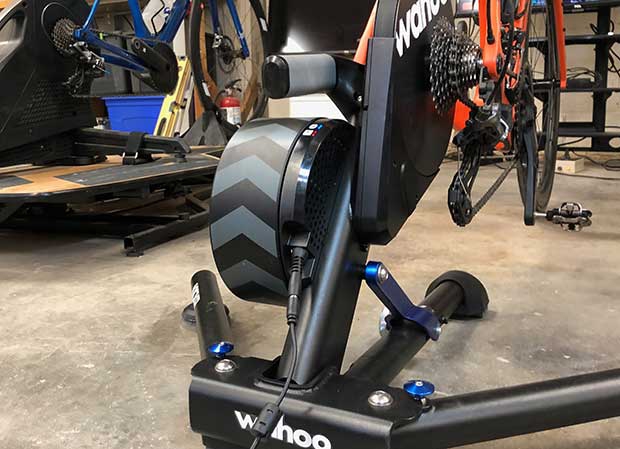
Saris gave us another kind of road feel with its MP1 platform, and the feature upgrade that most appeals to me from this new KICKR launch is that sort of road feel. Above is the new KICKR against the backdrop of an MP1 platform, and I had these side-by-side in my workshop so that I could compare the two. The MP1 costs as much as an entire KICKR, which is just a tick under $1,200. (This means the 5th gen KICKR I’m writing about now, just announced today, did not go up in price.)
But the point if this new KICKR is it grants you the side-to-side road feel that mimics riding on the road. Does it render the MP1 platform moot? Yes. Mind, the MP1 moves underneath you in 3 planes: back/forth, side to side, and rotationally. The KICKR relies only on elastomeric pods called AXIS Feet (below).
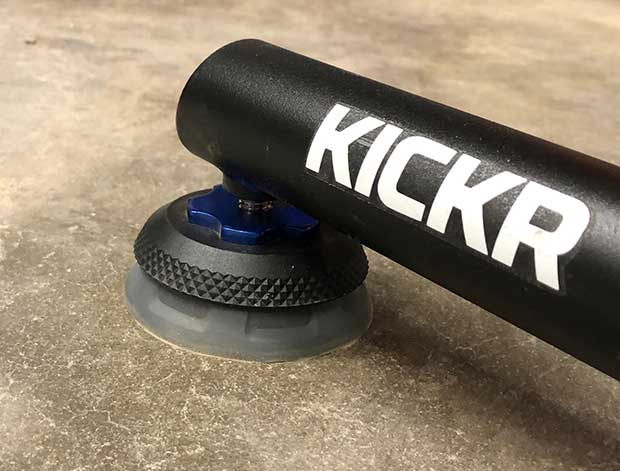
I was skeptical that just these feet could deliver the promise. But the darned things work. The Saris platform is a great concept and exceptionally built, but the movement is not subtle. This is especially the case when out of the saddle. The MP1 requires me to pay very specific attention to balance, and I actually get a little sore from the use of stabilizer muscles after a ride on it. Not so the new KICKR. The ride quality of this KICKR when seated is hard to recognize and you don’t really notice the movement until you get onto a traditional, rigid trainer and then you can tell the difference. But I can get used to just about anything.
The real value – what makes me “stand up” and notice (pardon the pun) – is when a system delivers roadlike quality when I’m out of the saddle. This is the major value of the AXIS Feet: roadlike quality, but with stability.
I am not symmetrical on my bike. I favor one side, not only in my pedaling, but in my posture. When I hop onto a trainer this is disconcerting, and it’s helpful if I can adjust the trainer to normalize for the quirky way I ride a bike. The AXIS Feet are robust! They’re big, they’re thick, and they adjust out far enough to allow me to normalize per my idiosyncratic riding style.

“Of course!” you might say. But the KICKR Bike – which I love – did not give me the same footpod adjustability that the new KICKR does. See that center stabilizing leg that emanates from the enter of the KICKR in the image above? The KICKR Bike has this as well, but it’s too “proud” to allow me to normalize the bike using the adjustable feet. And, no, I can’t replace footpods in the KICKR Bike with the AXIS Feet. But…!
The AXIS Feet can be retrofit into existing KICKRs of all generations. The pitch of the threads on the feet of KICKRs changed after gen-2, but if you buy AXIS Feet as an accessory, they will come with feet for both thread pitches, so all KICKRs are covered. AXIS Feet will sell for $79.99, so you could enjoy my major upgrade feature of this new KICKR with this purchase, assuming you have a perfectly good KICKR already.
Here’s a video from Wahoo Fitness that demos the action of the AXIS Feet:
While I don’t know this, I would wager that AXIS Feet – with their thick elastomeric mass between the KICKR and the floor – improves the already-quiet gen-5 KICKR for those on the floor beneath the rider, and would quiet down the vibration of older-gen KICKRs ridden on flexible floors.
The new KICKR also claims an increase in accuracy from +/- 2% to +/-1%, and it auto-calibrates (no need for a spindown to calibrate). I haven’t had the KICKR long enough to engage in multiple rides with all my various PMs, but I confess I don’t know if I have the capacity in my workshop (or in my brain) to tweeze out that degree of granularity.

Let’s get back to the features question because, per the way I began this conversation, we have features now that we didn’t have when smart direct drive trainers burst onto the scene. My understanding of all these new features is incomplete, but it seems to me they are not all currently available in one integrated setup. At any price. Point being, think about what you want before you just start spending money.
For example, let’s say you’re a dedicated Zwifter. You might want to add steering as a feature. This is available using a STERZO Smart from Elite. But you can only do this if you have a front wheel on the bike you’re riding, and this disqualifies all smart bikes, and the KICKR Climb, unless there’s something I misunderstand. I know of no tech that gets around this. Therefore, you need to choose between incline and steering. You can’t have them both. What would I rather have? I don’t know. Incline most likely. But I haven’t ridden with a STERZO Smart, so I don’t know.
A note on steering + incline: If you read my review of the KICKR Bike you'll note there are buttons on the shifters that are for future functionality. The idea behind those buttons is, I believe, steering. But that functionality is not yet turned on. Once this goes live, then you'd have incline + steering in the same bike. Not AXIS Feet! But incline + steering. When this moves from thought balloon to functionality I'll let you know.
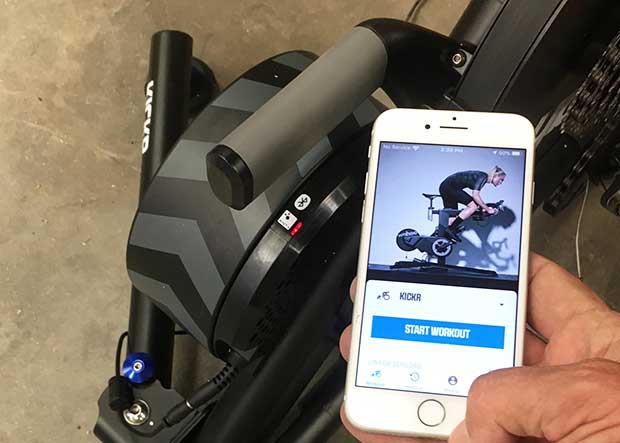
This new KICKR was easy to assemble out of the box, and typically easy to configure. You use the Wahoo Fitness app (the all-black icon), not the Wahoo ELEMNT app, and you'll almost certainly get a prompt from the app to upgrade the firmware of the KICKR before you proceed. Do this FIRST. Do this before you attempt to pair with Zwift. While the KICKR should BLE pair with Zwift on its own, I found that not to be the case. I first had to process the firmware upgrade. Other than that, this KICKR is easy plug-and-play, typical of Wahoo products.
This new Wahoo Fitness KICKR is available now, though (via my best intel) the AXIS Feet as a retrofit for your existing KICKR isn’t schedule to arrive for sale for several more weeks.


